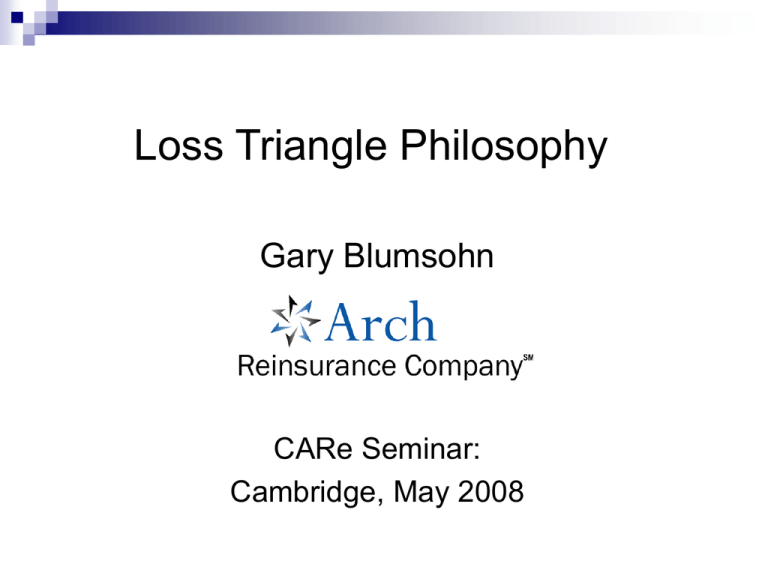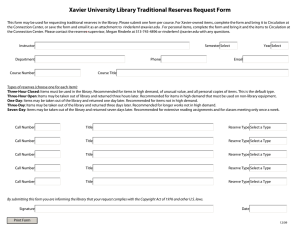Loss Triangle Philosophy Gary Blumsohn CARe Seminar: Cambridge, May 2008
advertisement

Loss Triangle Philosophy Gary Blumsohn CARe Seminar: Cambridge, May 2008 Background Committee on Reinsurance Research Practical questions: Actuaries mostly learn to do loss development on the job Can we give guidance to improve approaches – especially on unstable triangles? The Questions What types of averages do people use? Statistical tests and methods Smoothing Reversals Downward development Ignore tail-factor issue Initial Attempt 12-year excerpt from RAA GL Fac Too stable! 40 responses Mean loss reserve estimate = $1.6 billion SD of loss reserve estimates = $0.2 billion CV = 13% Second Attempt: Umbrella incurred loss triangle Accident Year 1991 1992 1993 1994 1995 1996 1997 1998 1999 2000 2001 2002 1 1,782 430 2,234 3,335 2,006 7,640 6,643 2,474 4,229 2,065 3,448 1,736 2 3,000 2,814 3,902 12,937 5,406 8,485 13,184 9,684 6,135 2,982 4,240 3 6,924 3,557 10,841 23,694 9,802 12,085 18,530 10,636 5,972 3,384 4 10,167 5,745 14,262 20,477 8,949 13,515 17,782 16,266 8,613 5 12,369 9,033 17,666 19,715 10,611 15,418 20,867 16,649 6 14,047 7,884 19,154 23,689 10,623 18,894 21,358 7 13,577 8,715 19,411 23,955 16,633 19,029 8 14,289 8,982 19,021 25,066 16,699 9 13,831 9,048 18,854 25,269 10 14,419 8,934 19,085 11 14,563 8,856 2.308 1.264 2.778 1.831 1.813 1.424 1.405 1.098 0.973 1.135 1.468 1.615 1.316 0.864 0.913 1.118 0.960 1.529 1.442 1.217 1.572 1.239 0.963 1.186 1.141 1.173 1.024 1.136 0.873 1.084 1.202 1.001 1.225 1.024 0.967 1.105 1.013 1.011 1.566 1.007 1.052 1.031 0.980 1.046 1.004 0.968 1.007 0.991 1.008 1.043 0.987 1.012 1.010 0.991 0.995 Age-to-age 1991 1992 1993 1994 1995 1996 1997 1998 1999 2000 2001 1.684 6.544 1.747 3.879 2.695 1.111 1.985 3.914 1.451 1.444 1.230 12 14,484 Responses “Great and gutsy project!” “I believe the whole notion of "picking factors" with no statistical guidance is something of a disgrace to the profession…” Responses (cont.) “While it may be helpful to share ideas on how to pick LDFs, it is vital that more information than just the triangle at hand be considered… I wouldn’t make selections without other information such as individual claim information, changes in the underlying business, comparison to competitor or industry triangles if available, etc. Of course you can’t always get the information you want……but I would hate to see people come to the seminar and learn some new selection techniques that don’t look beyond the triangle.” ATA factors 3.0 2.8 2.6 2.4 2.2 2.0 1.8 1.6 1.4 1.2 1.0 0.8 0 51 responses 2 4 6 Development age 8 10 ATU factors 12.0 10.0 8.0 6.0 4.0 2.0 0.0 0 2 4 6 Development Age 8 10 # of responses Frequency of Reserves 17 15 13 11 9 7 5 3 1 -1 Implied Reserves (in $millions) 13 18 23 28 33 38 43 48 53 58 Projected loss reserve ($millions) Percentile Cumulative Distribution of Loss Reserves 100% 90% 80% 70% 60% 50% 40% 30% 20% 10% 0% Mean - 20 40 Loss Reserves ($millions) 60 Mean 28.0 Std. Dev 8.3 Minimum 10.7 2nd lowest 18.3 25th percentile 23.7 Median 26.2 75th percentile 31.1 2nd highest 55.2 Maximum 60.2 Loss Reserves (in $millions) Mean Loss Reserve Rptd to date High Low Median 30 25 20 15 10 5 0 1992 1993 1994 1995 1996 1997 1998 1999 2000 2001 2002 “Actuaries must not pretend to judge what they cannot scientifically model.” Leigh Halliwell Variance, Vol. 1, Issue 2, p. 216 Skeptic’s view of statistical methods Statistical methods measure the past You have how many data points?!! Blow-ups more likely to be from things that aren’t in the data than from 1-in-10,000 events. Task Force On The Reputation Of Casualty Actuaries Economic Perspective Complete determinism: Know the future Perfect Knowledge Stochastic determinism: Know the future statistically Risk No determinism: Don’t know distributions Uncertainty Blumsohn, PCAS 1999, p. 31 “If you cannot measure, your knowledge is meager and unsatisfactory.” Lord Kelvin The Dilemma Your knowledge is meager and unsatisfactory, but your boss needs an answer Frank Knight, on the practical meaning of Kelvin’s statement for social scientists: “If you cannot measure, measure anyhow.”



